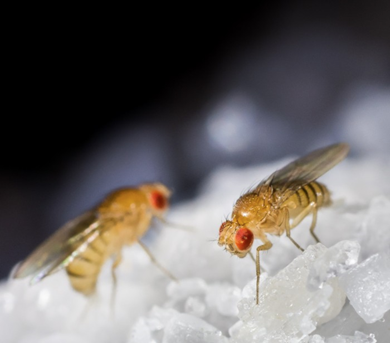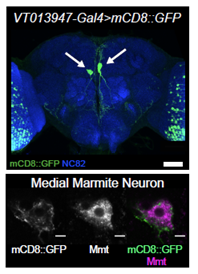
Excited to share our new manuscript on a novel #neuropeptide family that regulates #feeding across #evolution. Kudos to @Pat_TFrancisco for tackling this challenging project and coming up with the name @marmite . #homeostasis biorxiv.org/content/10.110… 1/22 



Also kudos to all our collaborators @TastekinIbrahim @EzraGili @fern1_ana @BartDeplancke @albinojorgemai @alisson_gontijo which allowed us to expand the scope of our study and contributed critical insights. It takes a village 2/22
The sequencing of #genomes has been a major milestone in #biology. We have precise maps of the #genome of animals and we think that we know all the major players. Especially the conserved ones which are so important that most animals have them. But is it really like that? 3/22
#Neuropeptides are molecules that regulate the brain. They communicate between different parts of the brain, changing how information is processed. They often signal changes in the animal's state and influence what the brain cares about. #neuroscience 4/22
But #neuropeptides are small, rapidly evolving, and difficult to identify. So the question is if we know them all? Or are there some which remain to be discovered and characterized? 5/22
The fruitfly #Drosophila has pioneered discoveries in #genetics and #genomics. Its genome was one of the first to be sequenced and much of what’s known about the molecular basis of development and behavior was discovered there. So, we used flies to do some discovery science. 6/22 

Wading through data from the lab @Pat_TFrancisco @BartDeplancke & @EzraGili found a lonely, small, uncharacterized gene called CG14075 in the fly genome. Upon closer examination, it seemed it could be a #neuropeptide. But what does it do? 7/22 

Pat used #CRISPR to delete CG14075 from the genome and study its function. She found that mutants without CG14075 ate more protein than controls, and overexpression suppressed protein intake. Sugar feeding was unaffected. We had a phenotype! #nutrition 8/22 



We wondered if CG14075 encoded a satiety signal for protein/amino acids. We removed an amino acid from the diet (using the holidic medium - THANKS @mattpiperlab) and checked how expression changed. Removing AAs from the diet decreased CG14075 expression. 9/22 

We concluded that CG14075 is a novel putative neuropeptide gene which signals the amino acid state of the animal and changes how much protein it eats. So it is all about deciding to eat protein or not. To love it or hate it. So Pat decided to name the gene @marmite (mmt) 10/22 

Where in the brain does @marmite act? @Pat_TFrancisco used genome engineering to insert a new gene in place of mmt to see which cells express it. It is only in very few neurons in the fly brain! This and an antibody allowed us to further study the properties of these cells. 11/22 

Are the cells we are labeling really responsible for controlling protein appetite? We used genetic tricks to turn these neurons on or off in animals with or without mmt. And indeed we can change protein appetite in a predictable way by doing that. And it depends on Mmt. 12/22 

The brain is very complex. Often different neurons do different things even if they express the same molecules. With the help of Eagle Eye @TastekinIbrahim (an amazingly gifted neuroanatomist) we screened libraries of flies to find ones only labeling subsets of mmt neurons. 13/22
We found that one line which labeled only one pair of mmt+ neurons recapitulates the protein appetite phenotype. We call these neurons the Medial Marmite Neurons. We love fly genetics! 14/22 



But mmt was still a lonely gene. Or did it have a family? This is where we teamed up with the awesome @alisson_gontijo the peptide gene and genome analysis magician to help mmt find its relatives. Digging around he found that mmt was part of an ancient #neuropeptide family. 15/22
And here is where we managed to reconnect @marmite with its vertebrate relatives. It turns out that @marmite is related to Neuropeptides B and W – two poorly understood vertebrate #neuropeptides which had been shown to control #feeding in mice and rats. BINGO! 16/22 

The challenge when studying neuropeptide evolution is that these genes evolve very rapidly and often the conservation at the amino acid level is difficult to pin down. 17/22
To test if mmt and NPB/W could have a conserved function we decided to put the vertebrate genes into fly brains and see what happens. Indeed, the human NPB and NPW suppressed protein appetite as well as mmt. Does this mean that marmite could change feeding in vertebrates? 18/22 

We work in a highly collaborative community @Neuro_CF and so we reached out to @albinojorgemai @fern1_ana to test this crazy idea. They immediately said yes. When we overexpress NPB or mmt in mouse brains animals changed feeding. Both genes are functionally conserved! 19/22 

We hope you enjoy reading about our journey of how we discovered a new corner in the fly genome. How we met @marmite, added a new modulator of protein appetite to the repertoire of the fly brain, and brought together mmt with its vast and ancient family of relatives. 20/22
Thanks to all the funders @fct_pt @ciencia_pt @ERC_Research & especially @champalimaudF who supported this discovery science project. Because the unknown is vast. And if we do not support discovery science we will never push beyond the boundaries of current knowledge. 21/22
And as a special treat here is the @marmite abstract reinterpreted, sung, and animated by our new AI #hiphop and #rap overlords #chatgpt3 @OpenAI. TURN ON THE SOUND! #science #neuropeptides #brain #feeding #nutrition 22/22
• • •
Missing some Tweet in this thread? You can try to
force a refresh




